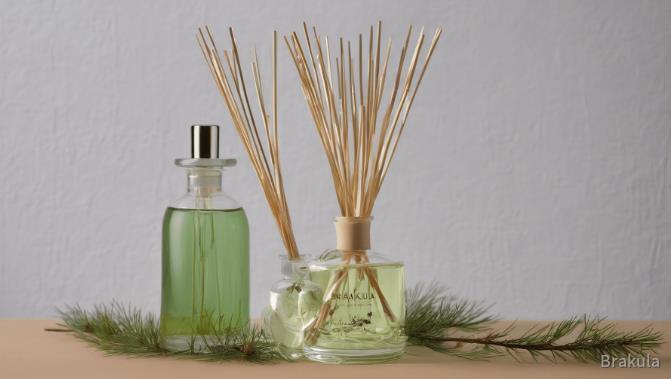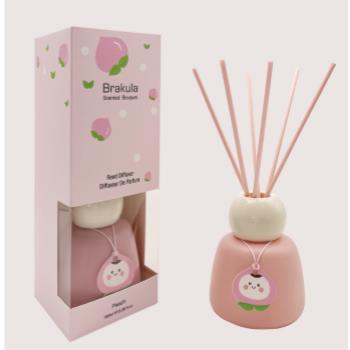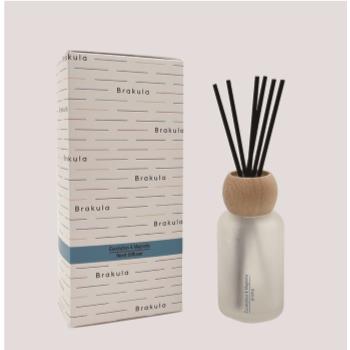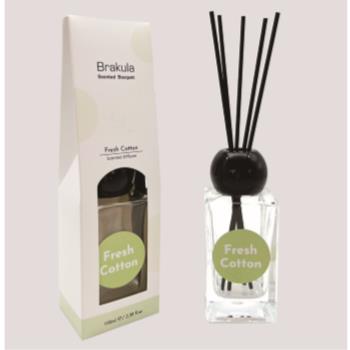How to Use Aroma Diffuser with Sticks: The Ultimate Guide
Discover the benefits of aromatherapy including fragranced oil and happiness reed diffuser scents, and how it can enhance your mood and well-being with fragrance oil and reed diffuser oil Using an aroma diffuser with reed sticks and fragrance oil is easy and fun. It allows you to create a calming atmosphere in any room with diffuser oil, fragrance oil, and a reed diffuser size that suits your needs. Whether you're unwinding after a long day with a reed diffuser or setting the mood for a gathering using diffuser oil, this guide has you covered. Get ready to fill your home with delightful scents from a reed diffuser that uplift and refresh!

Understanding Reed Diffusers
Definition
Reed diffusers are a safe and stylish alternative to traditional candles. They provide a gentle and continuous fragrance for your home using a reed diffuser. Unlike candles, they do not require an open flame. This makes them ideal for households with children or pets, such as a reed diffuser.
Mechanism
Diffuser reeds play a crucial role in how reed diffusers work These reeds absorb the scented oil from the container. As the oil travels up the reed, it evaporates into the air, using the release of the fragrance. This process creates a steady scent in your space with a reed diffuser without any heat source.
Materials Used
Most diffuser reeds are made of natural materials like rattan or bamboo. These materials are porous, which means they can effectively hold and release fragrance, making them ideal for a reed diffuser. The porosity of the reeds allows them to use draw the oil up easily. Different types of reeds may vary in thickness and length, affecting how quickly they diffuse the scent.
Reed Diffuser Sizes
Reed diffusers come in various sizes. A 100ml reed diffuser typically lasts around three to six months. Smaller reed diffusers are also available for compact spaces. Choosing the right size of your reed diffuser depends on your room's dimensions and desired scent strength.
Scent Strength
The strength of the reed diffuser smell can change based on several factors. The number of reeds used directly impacts how strong the scent will be. More reeds mean a stronger fragrance, while fewer reeds use a subtler aroma. It is essential to find a balance, like a reed diffuser, that suits your preferences.
Benefits of Reed Diffusers
Using reed diffusers offers several advantages:
No flames: They eliminate fire hazards.
Low maintenance: They require little upkeep compared to candles.
Long-lasting: They provide continuous scent for weeks.
Variety: Many beautiful reed diffusers are available to match your decor.
Popular Scents
Happiness reed diffusers often feature uplifting scents like citrus or floral notes. These scents from a reed diffuser can enhance your mood and create a welcoming atmosphere. Choosing scents that resonate with you, like a reed diffuser, adds to the overall experience.
Placement Tips
To maximize fragrance diffusion, place your reed diffuser in areas with good air circulation. Avoid direct sunlight on the reed diffuser as it may degrade the oils over time. Common places include living rooms, bedrooms, or bathrooms with a reed diffuser for a pleasant ambiance.
Step-by-Step Guide for Use
Initial Setup
Start by preparing your aroma diffuser. Remove any seals from the bottle of essential oil. This step is crucial as it allows the reed diffuser fragrance to flow freely. Next, insert the reeds into the oil. Make sure they are fully submerged. The reeds use to absorb the oil and release the scent into the air.
Keep in mind that using high-quality essential oils and a reed enhances the experience. It also ensures a stronger and longer-lasting fragrance throughout your home when you use reed.
Flipping Reeds
Flipping the reeds is an important step. Do this immediately after placing them in the oil. This action helps to enhance scent release right from the start using a reed. The oil travels up the reeds, but it can take time to use for it to saturate completely. By flipping them, you use a reed to expose more surface area to the air, allowing for better diffusion.
Consider using the reeds and flipping them every few days to maintain a strong scent. This simple act, using a reed, keeps your space smelling fresh and inviting.
Safety Precautions
Using a reed aroma diffuser with sticks requires some safety measures. Place a tray under your reed diffuser to catch any spills. Essential oils can stain surfaces, so use a reed to protect your furniture.
If you have children or pets, ensure that the reed diffuser is out of reach. Some oils may not be safe for them. Always use check labels for warnings about safety around kids and animals.
Maintaining Your Diffuser
Maintenance is key to prolonging the life of your aroma diffuser. Regularly check the oil level in your bottle. When it runs low, use it to refill with more essential oil. Avoid using letting the reeds dry out completely, as this can affect their performance.
Clean your diffuser periodically to prevent buildup of residue. Use warm water and mild soap to wipe down the bottle and reeds if necessary.
Choosing Oils
Choosing the right oils can influence your experience at home. Different scents evoke various feelings and memories. For example, lavender promotes relaxation while citrus scents energize.
Experiment with different fragrances to find what works best for you and your living space. Mixing oils can create unique blends tailored to your preferences.
Caring for Your Diffuser
Flipping Reeds
Flipping the reeds in your reed diffuser is crucial. This action helps maintain optimal fragrance levels. It is recommended to flip the reeds every week. Doing this allows fresh oil to rise and keeps the scent strong.
If you notice the fragrance fading, it may be time to flip them more frequently. Regular flipping ensures that the diffuser oil reaches all parts of the reed. This maximizes scent distribution in your space.
Replacing Reeds
Changing oils means changing reeds. Old reeds can retain scents from previous oils. This can mix with new scents and create an unpleasant aroma. To ensure maximum scent absorption, replace the reeds when switching oils.
New reeds absorb and release oil better than old ones. They help deliver a clean, fresh fragrance. Always keep extra diffuser sticks on hand for convenience.
Avoiding Old Reeds
Old reeds can clog over time. Clogs reduce effectiveness and prevent proper scent diffusion. Using old reeds may lead to disappointment with weak or no fragrance.
It is best to avoid reusing old reeds altogether. They will not provide the same quality of scent as new ones. Investing in new reed diffuser oils and sticks ensures a better experience with your diffuser.
Choosing Oils Wisely
Not all oils are suitable for diffusers. Some harmful diffuser oils can cause irritation or allergic reactions. Always check labels before purchasing scented oils. Look for oils specifically designed for use in diffusers.
Using high-quality scented diffuser oil enhances your experience. Avoid synthetic fragrances as they may not diffuse well. Natural essential oils are often a better choice for health and fragrance quality.
Reed Diffuser Size Recommendations
The size of your reed diffuser matters too. Larger spaces require larger diffusers or more reeds to spread the scent effectively. Smaller rooms can benefit from smaller diffusers with fewer reeds.
When choosing a reed diffuser tray, consider its size and style as well. A tray that fits your decor can enhance the overall look while serving a practical purpose.
Cleaning Your Diffuser
Cleaning your diffuser regularly extends its life. Dust and residue can build up and affect performance. Wipe down the glass or ceramic part of the diffuser with a damp cloth.
Make sure to clean out any leftover oil before adding new ones. This step prevents unwanted mixing of scents and maintains freshness.
Choosing the Right Size
Room Dimensions
Choosing the right size for your aroma diffuser is crucial. Consider the room dimensions first. A small diffuser may not effectively scent a large room. Conversely, a large diffuser can overwhelm a small space.
For example, in a living room measuring 15 by 20 feet, a larger vessel works best. A diffuser with a capacity of at least 200 milliliters can fill the space adequately. In contrast, a bathroom of about 5 by 8 feet can use a smaller model. A diffuser with a capacity of 100 milliliters will suffice.
Intended Fragrance Strength
Think about how strong you want the fragrance to be. This choice affects the number of sticks you should use. More sticks release more scent. If you prefer a subtle aroma, fewer sticks are better.
For instance, if you place a diffuser in an open area like a hallway, use more sticks to ensure the fragrance travels well. In private spaces, like bedrooms, fewer sticks create a calming atmosphere without being overpowering.
Airflow and Foot Traffic
Airflow plays a significant role in how well the fragrance spreads. High foot traffic areas can dilute scents quickly. Therefore, opt for larger diffusers in busy spaces.
In rooms with windows or fans, airflow can disperse scents faster. Choose a diffuser that matches this dynamic. For example, in an office with frequent movement and open windows, a diffuser with a capacity of 300 milliliters is ideal.
Suitable Sizes for Various Spaces
Different spaces require different sizes for optimal scent distribution. Here are some examples:
Living Room: Use a vessel that holds at least 200 milliliters.
Bedroom: A smaller option around 100-150 milliliters works well.
Bathroom: A compact diffuser of about 100 milliliters is sufficient.
Kitchen: A medium-sized vessel (150-200 milliliters) helps mask cooking odors effectively.
Choosing the right size ensures your aroma diffuser performs well. It also helps maintain the desired ambiance in any room.
Flipping and Changing Reeds
Flipping Reeds
Flipping the reeds regularly is essential for maintaining a strong fragrance. Many reeds can absorb oil effectively, but they also need attention. Every week or two, turn the reeds upside down. This action helps to refresh the scent. The part that was in the oil will now be exposed to the air. This exposure allows for better diffusion of fragrance.
Reeds can become saturated over time. When this happens, their ability to release scent diminishes. By flipping them, you ensure that all sides are used. This simple act can extend the life of your aroma diffuser significantly.
Identifying Condition
It’s important to know when to change the reeds. Look for signs of wear and tear. If the reeds appear discolored or dry, it’s time for a replacement. Natural reeds like rattan and bamboo may show these signs faster than synthetic options.
Another indicator is the scent strength. If you notice a weak fragrance despite flipping, consider changing the reeds. Fresh sticks will enhance the aroma experience. Premium quality rattan reeds often last longer than cheaper alternatives. They provide a more consistent scent release.
Changing Reeds
Changing the reeds should align with changing the oil for optimal results. Over time, oils lose their potency and become less effective. When you replace your essential oil, swap out the old reeds as well. Using new reeds with fresh oil maximizes fragrance diffusion.
To change the reeds, remove the old ones from the bottle carefully. Place new reeds into the oil-filled container. Ensure that there are enough sticks; using many reeds can help disperse fragrance more evenly throughout a room.
Choose slender reeds if you prefer a subtler scent. Thicker sticks release stronger aromas but may require more frequent changes.
For best results, check your diffuser every month. This routine ensures freshness in both oil and reeds. Regular maintenance keeps your space smelling delightful.
Maximizing Fragrance Strength
Adjusting Reeds
Adjust the number of reeds in your aroma diffuser. Using more reeds will increase the oil strength and fragrance intensity. Fewer reeds will create a subtler scent. A good starting point is to use five to seven reeds. This allows for a balanced aroma without overwhelming the space.
Experiment with the number of reeds until you find the right balance. If the scent is too strong, reduce the number of reeds. If it’s too weak, add a few more. The size of the room also plays a role. Larger rooms may need more reeds to fill the space effectively.
Placement Matters
Placement of the diffuser affects how well it disperses scent molecules. Position it in a location where air circulates freely. Avoid placing it near walls or in enclosed spaces. Ideal spots include shelves or tables away from corners.
Try different locations to see which works best for you. For example, placing it near a window can help disperse the fragrance outdoors. If you have pets or children, consider higher surfaces for safety.
Regular Maintenance
Regular maintenance keeps your aroma diffuser working efficiently. Change out the filled fragrance oil every three to four weeks. This prevents the scent from becoming stale and ensures a fresh aroma.
Clean the diffuser regularly as well. Wipe down the inside and outside with a soft cloth. Use warm soapy water to remove any residue from previous oils. Rinse thoroughly to avoid mixing scents.
Replace reeds every month or two, depending on usage. Over time, reeds can become saturated and less effective at delivering scent molecules into the air.
Scent Selection
Choosing the right scented oil is crucial for maximizing fragrance strength. Essential oils offer various benefits beyond smell. They can uplift your mood or promote relaxation.
Look for quality fragrances that suit your preferences. Some popular options include lavender for relaxation and citrus for energy. Experiment with blends to create a unique aromatic experience.
Oil Volume
The volume of fragrant oil in your diffuser affects its performance. Ensure that you fill it adequately but don’t overfill it. Too much oil can lead to spills and messes, while too little may not provide enough fragrance.
For optimal results, keep an eye on the oil level and refill when necessary. This simple step ensures consistent scent distribution throughout your space.
Optimal Placement Tips
High-Traffic Areas
Choose high-traffic areas for your aroma diffuser. These spots allow scents to spread easily throughout the room. Living rooms and hallways are great options. The more people move around, the better the fragrance disperses.
Place the diffuser in a location where it can be noticed but not obstructed. This way, everyone can enjoy the aroma without interference. Avoid corners or small spaces that may trap the scent.
Avoid Direct Sunlight
Avoid placing the diffuser in direct sunlight or near heat sources. Sunlight can degrade essential oils quickly. Heat can alter their chemical structure, reducing effectiveness.
Keep diffusers away from windows and heaters. Instead, choose shaded areas that maintain a stable temperature. This helps preserve the quality of the oils for longer-lasting fragrance.
Eye Level Placement
Positioning the diffuser at eye level enhances both aesthetics and fragrance reach. When placed higher, scents can become too concentrated at ceiling height. Lower placements might not distribute aromas effectively.
Eye level allows for an even distribution of scent throughout the space. It also makes the diffuser a decorative piece in your home. Consider using shelves or tables to achieve this balance.
Safety Considerations
Child Safety
Keeping reed diffusers out of reach is crucial. Children are naturally curious and may want to explore these items. Accidental spills can occur if they knock over the diffuser. This can lead to ingestion of essential oils, which can be harmful.
Pets also pose a risk. Cats and dogs might be attracted to the scent or the sticks. They could chew on them or tip over the diffuser. It’s best to place these items in high locations or closed-off areas.
Surface Protection
Using a tray under the diffuser is a smart idea. This simple step helps contain any spills that may happen. Essential oils can damage surfaces, especially wood or fabric. A tray acts as a barrier against oil stains.
Regularly check the tray for any leaks or drips. If you notice any, clean them immediately to prevent damage. Choosing a tray that matches your decor can enhance the look while keeping your surfaces safe.
Flammable Materials
Avoid placing reed diffusers near flammable materials. Items like candles, paper, or fabrics can ignite easily. The heat from these sources can also affect the diffuser's performance.
Keep diffusers away from heat sources like radiators or direct sunlight. High temperatures can alter the oils, affecting their scent and effectiveness. Always ensure that the area around the diffuser is clear of potential hazards.
Maintenance Care
Regular care is essential for safe use. Change the reeds every few weeks to maintain scent strength. Old reeds can become clogged, reducing effectiveness and possibly leading to spills.
Monitor the oil level in the diffuser as well. Refill it when it gets low to avoid exposing the reeds too much air. This keeps them functional and prevents drying out completely.
Proper Disposal
Dispose of used reeds and empty bottles properly. Essential oils can be harmful to the environment if not discarded correctly. Check local guidelines for disposal methods that are safe and eco-friendly.
Consider recycling glass bottles if possible. Many communities have programs for recycling such materials. This not only helps keep your home safe but also supports environmental efforts.
Closing Thoughts
Using an aroma diffuser with sticks can transform your space. You’ve learned how to choose the right diffuser, care for it, and maximize its fragrance. These steps ensure that you enjoy a pleasant atmosphere while keeping your diffuser in top shape.
Now it's time to put this knowledge into action. Experiment with different scents and placements to find what works best for you. Don’t hesitate to share your experiences and tips with friends or on social media. Your journey to a fragrant home starts now—embrace it!
Frequently Asked Questions
How does a reed diffuser work?
A reed diffuser uses sticks to absorb and disperse fragrance oils into the air. The oil travels up the reeds, releasing a pleasant scent gradually.
How long do reed diffusers last?
Typically, a reed diffuser lasts between 1 to 3 months, depending on the size of the bottle and the number of reeds used.
Can I reuse reeds in my diffuser?
It's not recommended to reuse reeds as they can become saturated with old scents. For optimal fragrance, replace them with new ones when changing oils.
How often should I flip the reeds?
Flipping the reeds every week or two helps maintain fragrance strength. This action allows for better oil absorption and scent release.
Are reed diffusers safe around pets?
Most reed diffusers are safe for pets, but always check the ingredients. Avoid essential oils that are toxic to animals, like tea tree or eucalyptus.
Where should I place my reed diffuser for best results?
Place your diffuser in a central location, away from direct sunlight and drafts. This enhances scent distribution and longevity.
Can I make my own reed diffuser?
Yes! You can create a DIY reed diffuser using essential oils, carrier oil, and bamboo sticks. It's a fun way to customize scents for your space.



